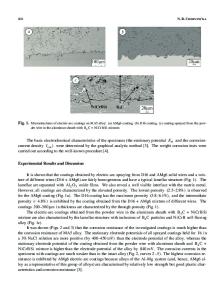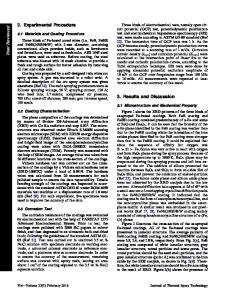Corrosion Resistance Behavior of Single-Layer Cathodic Arc PVD Nitride-Base Coatings in 1M HCl and 3.5 pct NaCl Solution
- PDF / 3,328,040 Bytes
- 12 Pages / 593.972 x 792 pts Page_size
- 15 Downloads / 315 Views
INTRODUCTION
PHYSICAL vapor deposition (PVD) techniques used for deposition of hard transition metal nitride (binary, ternary etc.,) coatings e.g., TiN, CrN and TiAlN, CrAlN are well known for their improved wear resistance, high hardness, lower coefficient of friction, thermal stability, chemical inertness, and corrosion resistance.[1–6] These characteristics have made them suitable candidates for application in different harsh environmental conditions[2] such as in cutting tools, turbine blades, molds, and dies. Cathodic arc deposition process is a PVD technique which offers very high deposition rate and produces coatings with excellent adhesion to the substrates.[7] However, defects, such as pinholes and micro-pores due to nitride layer columnar growth as well as inclusion from liquid droplets resulting into AKEEM YUSUF ADESINA and ZUHAIR M. GASEM are with the Mechanical Engineering Department, King Fahd University of Petroleum and Minerals, Dhahran 31261, Saudi Arabia. ARUMUGAM MADHAN KUMAR is with the Center of Research Excellence in Corrosion, Research Institute, King Fahd University of Petroleum and Minerals, Dhahran 31261, Saudi Arabia Contact e-mail: [email protected] Manuscript submitted August 20, 2016. Article published online January 5, 2017. METALLURGICAL AND MATERIALS TRANSACTIONS B
macro-particles within the coating, impair their corrosion resistance behavior.[5,8] This is because defects create a solution path between the coating and the substrate thereby compromising the effectiveness of resistance against charge transfer.[3,9] For this and other reasons, arc and plasma technologies are constantly being improved to ultimately enhance coating properties by reducing macro-particles, increasing deposition rate etc. Wen-Jun Chou et al.[10] study the behavior of TiN coatings on 304 SS in 5 pct NaCl and 1M H2SO4 + 0.05 M KSCN solutions. Using the standard salt spray and potentiodynamic polarization (PDP) test, they determined the critical coating thickness in the NaCl and H2SO4 solutions to be 0.7 and 0.3 lm, respectively. When the coating thickness is smaller than the critical thickness value corrosion current abruptly increased. Electrochemical impedance spectroscopy (EIS) and PDP were used to evaluate the corrosion resistance of TiN and TiAlN coatings on a martensitic stainless steel in 0.5 mol/l NaCl and 1 mol/l H2SO4 solutions by Yang Li et al.[1] They found that TiAlN coating present better corrosion resistance stability after 100-hour immersion than TiN coating, attributing the corrosion mechanism to adhesive failure of the coating. Also, Korablov et al.[11] studied the hydrothermal corrosive behavior of commercial TiAlN and CrN coatings for a range of VOLUME 48B, APRIL 2017—1321
parameters: temperature up to 1223 K (950 °C), water pressure 100 MPa, exposure time to the tune of 750 hours, and in various pH solutions. Their findings show that TiAlN and CrN coatings can sustain a working temperature of 973 K (700 °C) and 1073 K (800 °C), respectively. A comparative study conducted by Xing-zhao et a
Data Loading...











